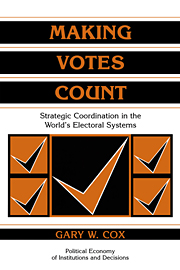Book contents
- Frontmatter
- Contents
- List of tables and figures
- Series Editors' Preface
- Preface
- PART I INTRODUCTION
- PART II STRATEGIC VOTING
- PART III STRATEGIC ENTRY
- PART IV ELECTORAL COORDINATION AT THE SYSTEM LEVEL
- 10 Putting the constituencies together
- 11 Electoral institutions, cleavage structures, and the number of parties
- PART V COORDINATION FAILURES AND DEMOCRATIC PERFORMANCE
- PART VI CONCLUSION
- APPENDICES
- References
- Subject Index
- Author Index
11 - Electoral institutions, cleavage structures, and the number of parties
Published online by Cambridge University Press: 05 August 2012
- Frontmatter
- Contents
- List of tables and figures
- Series Editors' Preface
- Preface
- PART I INTRODUCTION
- PART II STRATEGIC VOTING
- PART III STRATEGIC ENTRY
- PART IV ELECTORAL COORDINATION AT THE SYSTEM LEVEL
- 10 Putting the constituencies together
- 11 Electoral institutions, cleavage structures, and the number of parties
- PART V COORDINATION FAILURES AND DEMOCRATIC PERFORMANCE
- PART VI CONCLUSION
- APPENDICES
- References
- Subject Index
- Author Index
Summary
There does not exist a sustainable scientific proposition of high informative content concerning the effects of electoral systems that can be derived in complete isolation from social and political relations. The social, ethnic or religious homogeneity or heterogeneity of a society are very important for the structure of the party system.
Nohlen 1993:27Thus far in this book I have considered two levels at which political actors may face incentives to coordinate their actions. First, within individual legislative constituencies, voters or parties may need to coalesce in order to convert their votes into legislative seats more efficiently. Second, within the nation as a whole, would-be legislators and would-be executives may need to cooperate in order to convert their resources into executive office more efficiently. I have also stressed two broad influences on the outcome of the electoral coordination game, whether at the district or the national level: First, the nature of the electoral procedure pertinent to each level (the local electoral system by which legislators are elected, the national electoral procedure by which executives are elected); second, the nature of the social actors and cleavages involved at each level.
Chapter 10 suggested that coordination at both levels would be pertinent to explaining the number of parties at the national level: coordination at the district level by affecting the number of parties within each district, coordination at the national level by affecting the degree to which the local party systems cumulated into a national party system.
- Type
- Chapter
- Information
- Making Votes CountStrategic Coordination in the World's Electoral Systems, pp. 203 - 222Publisher: Cambridge University PressPrint publication year: 1997



